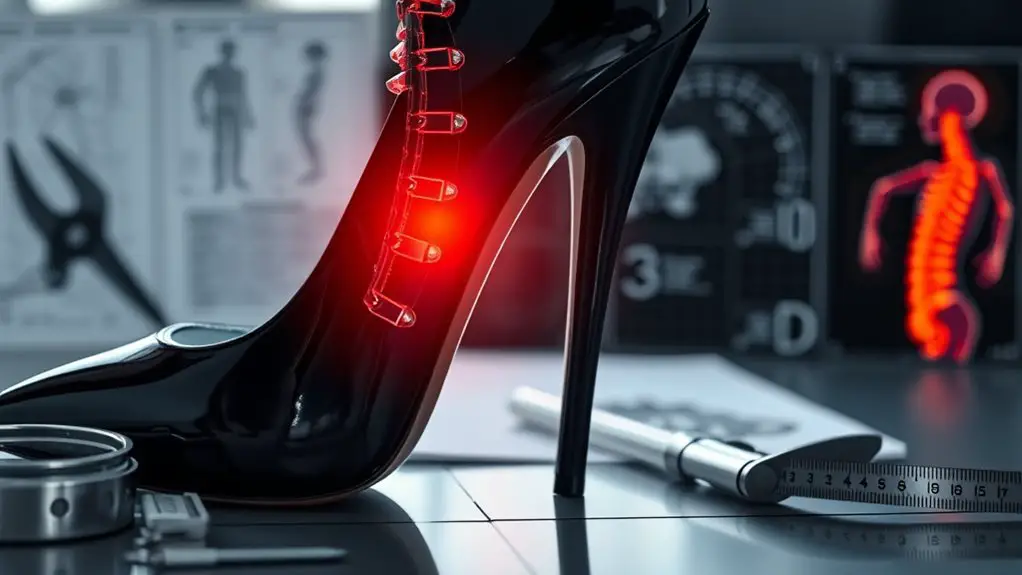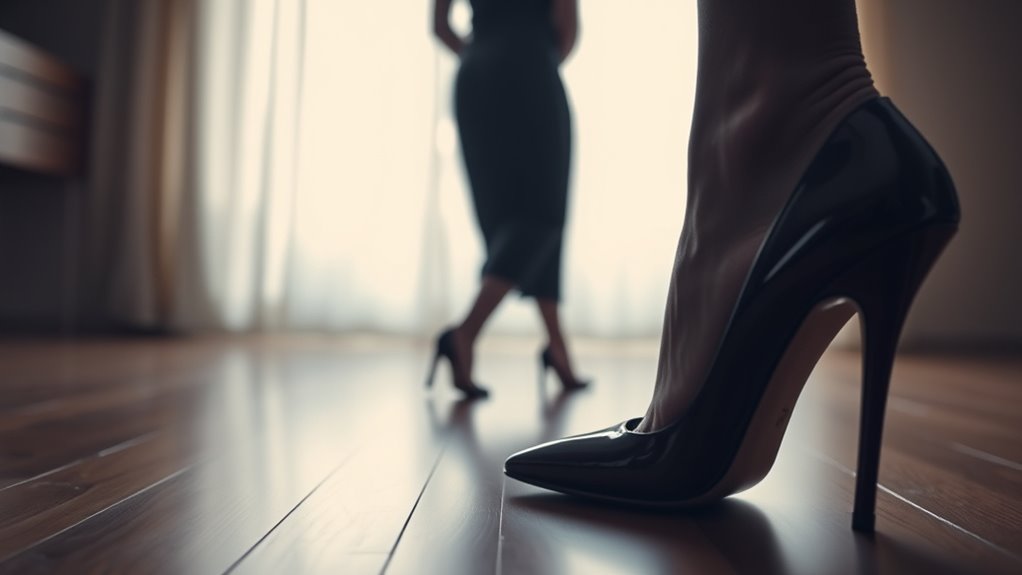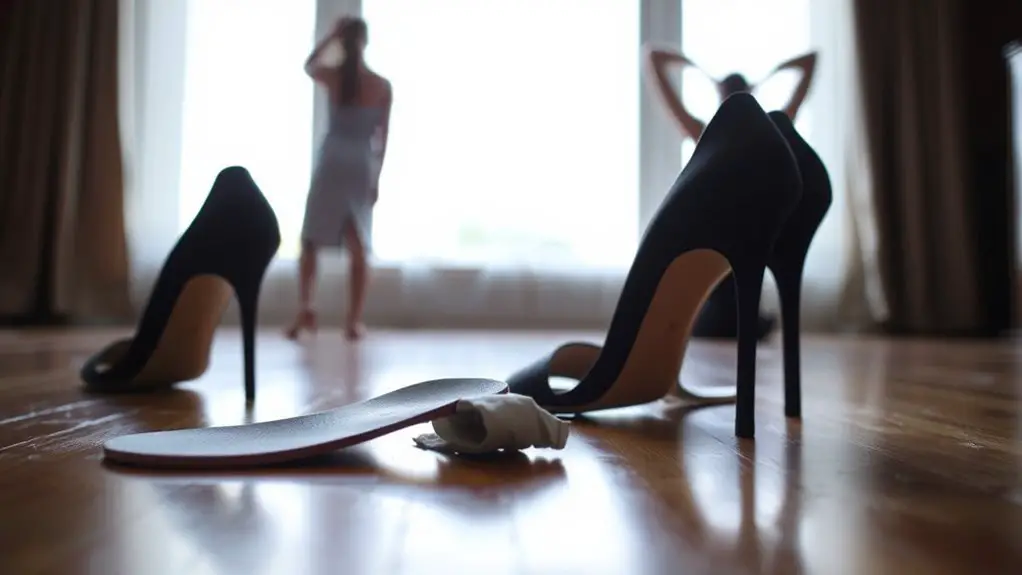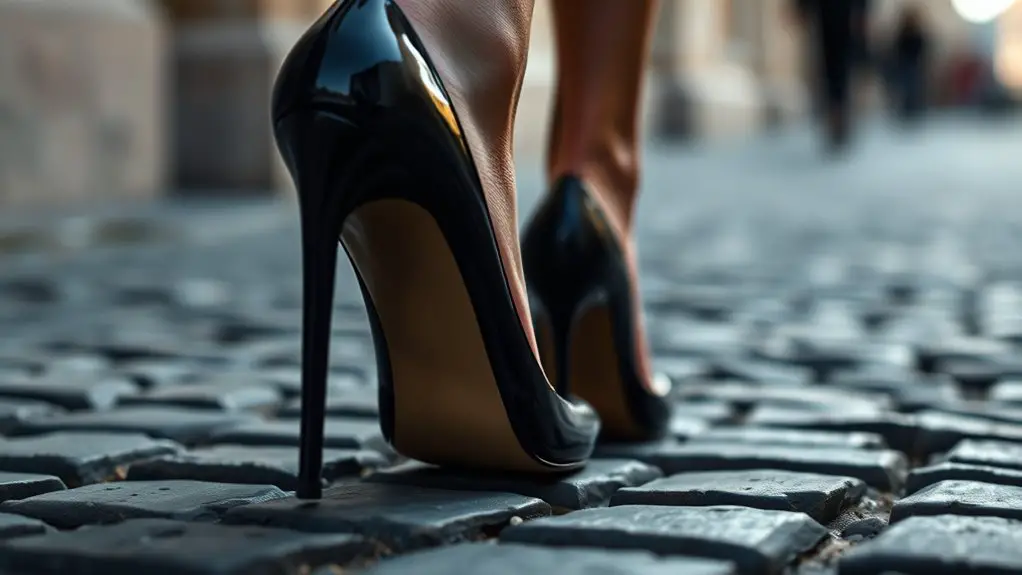Wearing high heels alters your posture and spinal alignment. The elevated heel shifts your center of gravity forward, increasing lumbar curve and straining the lower back. This unnatural positioning leads to muscular imbalances, tightness in calves, and weakening of essential stabilizing muscles. Over time, this can result in chronic back pain and discomfort. Understanding these factors can help you make better footwear choices and enhance comfort. More insights on managing the impact of heels await you.
The Anatomy of High Heels and Their Design

High heels are a distinctive footwear choice, characterized by their elevated heel and sleek design. The heel structure typically consists of a raised component that alters your foot’s angle, often leading to changes in weight distribution. This elevated heel is supported by a slender, narrow base, which is a key design feature, providing an aesthetic appeal while sacrificing stability.
The upper part of the shoe often features materials like leather or synthetic fabrics, designed for both comfort and style. The toe box can vary in shape, affecting how your foot fits within the shoe. Many high heels incorporate arch support, although it’s frequently minimal, contributing to discomfort during prolonged wear.
Understanding these design features is essential for recognizing how high heels influence your foot mechanics and potentially lead to discomfort or pain, particularly in the back and lower extremities.
How Heel Height Affects Posture
When you wear high heels, the elevation of the heel can greatly alter your posture. This change in heel height shifts your center of gravity, leading to adjustments in your body’s alignment. As a result, your spine may curve unnaturally, affecting your overall posture alignment.
| Heel Height (inches) | Impact on Posture Alignment |
|---|---|
| 1-2 | Minor adjustments, slight elevation |
| 3-4 | Noticeable shift in center of gravity |
| 5-6 | Significant curve in lumbar region |
| 7+ | Extreme tilt, increased back strain |
Understanding how heel elevation influences your posture is vital for managing potential discomfort. While high heels can enhance your appearance, they can also compromise your back health if worn frequently or for extended periods. Prioritize comfort to maintain proper posture alignment.
The Role of Foot Positioning in Back Pain

Although many people may not realize it, the positioning of your feet plays an essential role in the alignment of your spine and overall back health. When you wear high heels, heel elevation alters your foot mechanics, shifting your center of gravity forward. This shift can lead to an unnatural arch in your back as your body compensates for the imbalance, resulting in increased strain on your spine.
Proper foot positioning is important for maintaining spinal alignment. If your feet are not correctly aligned, it can lead to excessive pressure on your lower back, causing discomfort and pain. Additionally, the angle at which your foot meets the ground can influence how weight is distributed throughout your body. This distribution affects not only your back but also your hips and knees. Understanding foot positioning can be essential in mitigating back pain associated with high heels and promoting better overall spinal health.
Muscular Imbalances Caused by Heels
Wearing heels can lead to altered posture dynamics, greatly affecting your spine and overall alignment. This change often creates strength discrepancies in the muscles of your legs and back, which can contribute to discomfort and pain over time. Understanding these muscular imbalances is essential in addressing potential back pain associated with high heel use.
Altered Posture Dynamics
High-heeled shoes can considerably alter your posture dynamics, leading to muscular imbalances that may contribute to back pain. When you wear heels, your body undergoes altered biomechanics, shifting your center of gravity forward. This forces your pelvis to tilt and your spine to curve excessively, creating postural adaptations that strain your back muscles. As your calves tighten and your hip flexors shorten, the surrounding musculature becomes imbalanced, resulting in discomfort and potential injury. Over time, these adaptations can lead to chronic pain, as your body struggles to compensate for the unnatural alignment. Understanding these changes is essential, as it highlights the importance of choosing footwear that promotes a more natural posture, thereby reducing the risk of back pain associated with high heels.
Strength Discrepancies in Muscles
When heels elevate your feet, they can create significant strength discrepancies in the muscles of your lower body. This elevation shifts your body’s center of gravity, leading to overuse of certain muscle groups, particularly in the calves and quadriceps, while others, like the hamstrings and glutes, may weaken. As a result, you may experience muscle fatigue due to the constant strain on these overworked muscles. Additionally, these imbalances can contribute to balance issues, making it harder for you to maintain stability. Over time, these discrepancies can affect your gait and posture, further exacerbating back pain. Addressing these muscular imbalances through targeted strength training and stretching is essential for maintaining overall lower body health and reducing discomfort.
Long-Term Effects of Wearing High Heels

Although many women appreciate the aesthetic appeal of high heels, the long-term effects on foot and back health can be significant. Prolonged use of high heels often leads to chronic discomfort in the feet, which may escalate into issues like plantar fasciitis or bunions. The unnatural position of your feet can also disrupt the alignment of your spine, contributing to persistent back pain. Over time, these conditions may necessitate lifestyle adjustments, such as avoiding certain activities or seeking physical therapy. Additionally, wearing high heels can weaken specific muscle groups in your legs and back, leading to further imbalances and discomfort. The cumulative stress from wearing heels daily can result in degenerative changes, impacting your overall mobility. To conclude, while high heels may enhance your appearance, the potential long-term consequences on your health warrant careful consideration.
Tips for Reducing Back Pain While Wearing Heels
Wearing high heels can lead to significant discomfort, particularly in the back, but there are strategies that can help mitigate this pain. First, consider selecting heels with adequate heel support. Shoes that feature cushioning and arch support can distribute weight more evenly, reducing strain on your back.
Additionally, limit the time you spend in heels. Taking breaks to switch to more supportive footwear can provide necessary pain relief. When you wear heels, practice good posture by keeping your shoulders back and your spine aligned.
Limit your time in heels, take breaks for supportive footwear, and maintain good posture for relief.
Incorporating stretches and strengthening exercises for your back and legs can also alleviate discomfort. Remember to maintain a balanced gait and avoid uneven surfaces that may exacerbate back pain.
Lastly, if you experience persistent pain, consulting a healthcare professional for tailored advice is essential. By implementing these strategies, you can enjoy your heels while minimizing back pain.
Alternatives to High Heels for Style and Comfort
As you seek stylish alternatives to high heels, consider options that prioritize both comfort and aesthetics. Stylish flats are an excellent choice, as they provide a sleek appearance without the elevation that can lead to back pain. Look for designs that offer arch support and cushioning, enabling you to maintain a polished look while promoting foot health.
Supportive sneakers are another versatile option. With advancements in footwear technology, many sneakers now feature stylish designs suitable for a variety of occasions. These shoes often include supportive insoles and adequate cushioning, which help distribute body weight evenly and reduce strain on your back.
Additionally, consider ankle boots with a low, block heel. They offer a bit of elevation while maintaining stability. By choosing these alternatives, you can enhance your wardrobe without compromising comfort or risking back discomfort.
Frequently Asked Questions
Can Wearing Heels Affect Other Body Parts Besides the Back?
Yes, wearing heels can affect foot health and posture alignment, leading to issues like knee pain, hip discomfort, and even tension in the neck. It’s important to take into account these impacts when choosing footwear.
Are There Specific High Heel Styles That Are Less Harmful?
You’d think all high heels are equally damaging, but block heel styles and wedge heel options often provide more stability and distribute weight better, reducing the risk of discomfort compared to traditional stilettos.
How Often Should I Take Breaks From Wearing Heels?
You should take breaks every hour when wearing heels, as heel break frequency can greatly reduce strain. Additionally, consider heel height impact; lower heels generally require fewer breaks, promoting better foot and back health.
What Exercises Can Help Alleviate Back Pain From Heels?
To alleviate back pain from heels, incorporate stretching routines focusing on the hamstrings and hip flexors, alongside core strengthening exercises. These practices can enhance flexibility and stability, reducing discomfort and improving overall posture.
Do Different Materials Used in Heels Impact Back Pain?
Ever felt that nagging ache after wearing heels? The materials used in heels, especially their flexibility and heel height, can greatly influence your comfort, potentially exacerbating back pain if they lack proper support or cushioning.



